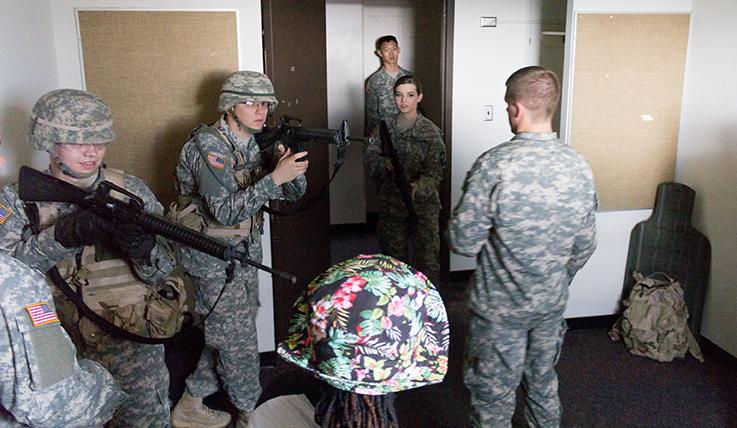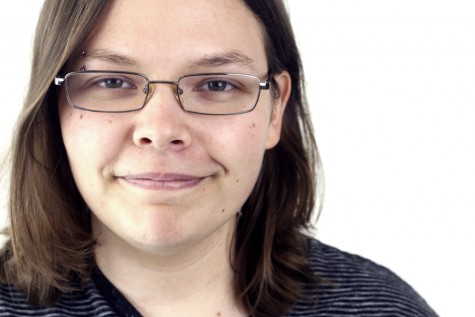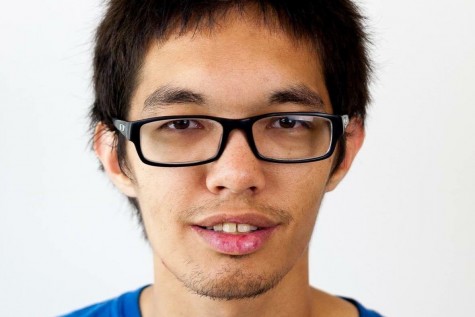ROTC receives training in Carman Hall
April 3, 2015
In the dark, abandoned floors of Carman Hall, sweat drips down the chin straps of their camouflage helmets as ROTC students, with black leather gloves gripping their rubber assault rifles, burst through the doors of vacant dorm rooms.
Each person who enters a room, most wearing army uniforms layered with tan vests and matching boots, steadies their weapon toward the walls as they clear one corner of the room at a time.
The first person who walks in, or “one-man,” pushes the door completely open to ensure no enemies are behind it, then heads toward the path of least resistance, which is opposite of the door’s hinges.
“Two-man” and “three-man” follow close behind, with three-man also clearing the center and ceiling, as the center of the room poses the biggest threat, until the final “four-man” enters.
The team leader yells “status,” which is followed by each team member reporting “one up,” “two up” and so forth until the leader determines that the room is clear.
About 60 students were divided into these training groups in the basement and first through third floors of Carman’s South Tower on Thursday.
Matthew Bailey, one of the squad leaders, told his group of about 13 students about the proper room-clearing procedures, including how important it is for one-man to always have his weapon up.
“This is called the high ready position because if someone was immediately right here, ready to shoot, and he had his weapon low, I’m going to kill him first,” he said. “Plain and simple.”
Bailey also told his group to always enter swiftly and quietly to gain the element of surprise over enemies.
“I’m shocked seeing him there with his weapon; he already has it up, and if he knows that I’m a threat and I have a weapon, I’m an actual enemy that’s aggressive, he would be able to kill me first,” Bailey said.
He also stressed not to shoot an enemy who does not have a weapon.
“We don’t shoot everyone; we only shoot people that need to be shot basically,” he said.
While he said the group should enter swiftly, Bailey also said not to run into the rooms because clearing a room fast does not equal clearing it completely.
“You could be missing something that could eventually hurt the next person,” he said. “So by doing it slowly, doing it smoothly, you’re going to be doing it faster than if you were sprinting.”
ROTC member Sydney Ryan asked what to do if a team member gets shot.
“So the first person walks in and they die; you see their head in the hallway, so do you guys all walk in? she asked.
Bailey said though it might seem mean, the person ahead of the team member who got shot should push them out of the way and the rest of the team should proceed in.
“If it creates a cluster, that’s more casualties,” Bailey said. “Your mission’s first; you want to kill the enemy, suppress the enemy before you ever start helping.”
Ryan said she enjoyed the experience, especially because the last couple training sessions involved going over terminology in the McAfee Gymnasium.
In an old associate resident director’s room, where socks, a pair of underwear, deodorant and plastic bottle caps, and other bits of trash could be seen scattered around the random leftover furniture, the students learned how to clear adjoining or complex rooms.
Daniel Alix, a military science professor, said the students were participating in MOUT training, or Military Operations over Urban Terrain, and learned techniques such as clearing rooms, hallways and stairwells.
He said in previous wars like WWII or Vietnam, soldiers would roll in with tanks and destroy buildings, but with recent wars in transitioning to fighting in major cities, there has been an emphasis on limiting collateral damage.
“To do that you have to send people in to make sure that there’s no enemy in these buildings, and that’s why we teach fighting in urban terrain,” Alix said. “It allows us to cut down on the losses of collateral damage, save a lot of buildings.”
Stephanie Markham can be reached at 581-2812 or samarkham@eiu.edu.

![[Thumbnail] Eastern's Old Main was quiet Thursday morning while educators who had left the office to strike picketed outside.](https://www.dailyeasternnews.com/wp-content/uploads/2025/04/Strike_01_LT_O-800x1200.jpg)












![[Thumbnail Edition] Senior Foward Macy McGlone, getsw the ball and gets the point during the first half of the game aginst Western Illinois University,, Eastern Illinois University Lost to Western Illinois University Thursday March 6 20205, 78-75 EIU lost making it the end of their season](https://www.dailyeasternnews.com/wp-content/uploads/2025/03/WBB_OVC_03_O-1-e1743361637111-1200x614.jpg)















![[thumbnail edition] Assistant Coach of the Linebackers, Rodman Noel talking to the linebackers about their positions at O'Brien Field on the Eastern Illinois University campus, Charleston Ill.](https://www.dailyeasternnews.com/wp-content/uploads/2025/04/FB_24_O-1-e1744671213207-1200x609.jpg)











































